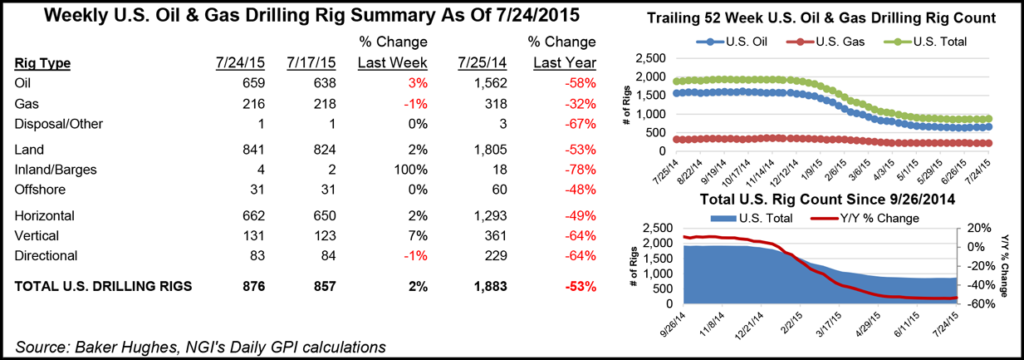E&P | NGI All News Access | NGI The Weekly Gas Market Report
19 U.S. Rigs Return, But More Needed to Lift Driller Profits
An impressive 19 units returned to action in the United States in the latest weekly census of active drilling rigs by Baker Hughes Inc. Seventeen land-based rigs were back in action along with two that were plying the inland waters.

Oil-directed rigs saw a net gain of 21 while the number of natural gas-directed rigs fell by 2. Horizontal rigs added 12, and eight vertical rigs joined the game while one directional rig dropped out.
Oil/gas breadbasket states Texas and Louisiana saw the biggest gains, adding eight and seven rigs, respectively. Three rigs were added in the Permian Basin and two in the Eagle Ford Shale. The Haynesville Shale added three rigs.
The latest count is in contrast to the previous week’s, which saw the U.S. count decline by six units (see Daily GPI, July 17). A week ago Canada added 23 rigs to its count. In the latest tally, Canada was up by eight rigs, making for a North America count increase of 27 as no rigs were added or lost in the Gulf of Mexico.
Rigs going back to work is good news for land drillers, but this apparent comeback isn’t nearly enough to lift profits in the depressed sector, according to analysts at Cowen and Company. “As activity recovers, standby rigs will need to be absorbed first before drillers can show any uptick in profitability,” they wrote in a July 21 note. “We estimate there are anywhere from 50-100 standby rigs industry wide, meaning the Baker Hughes rig count may need to increase by 50-100 before land drillers realize any upward revisions to earnings.”
© 2024 Natural Gas Intelligence. All rights reserved.
ISSN © 1532-1231 | ISSN © 2577-9877 | ISSN © 1532-1266 |
